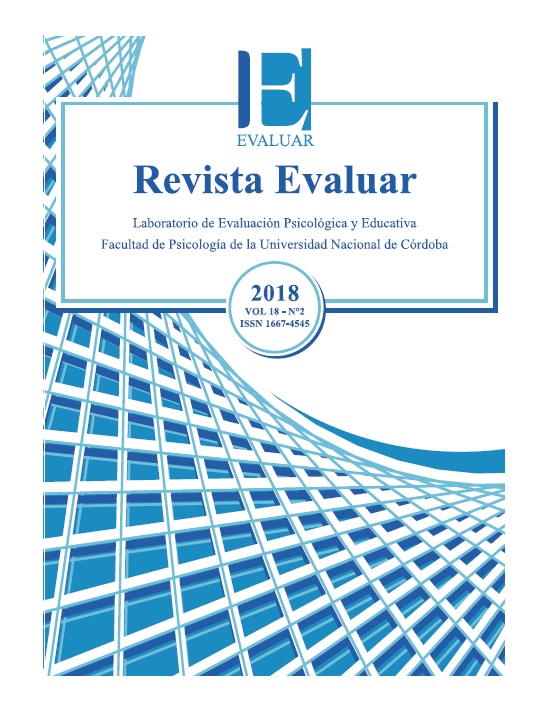Adaptation and validation of an instrument to evaluate the compassion construct
DOI:
https://doi.org/10.35670/1667-4545.v18.n2.20801Keywords:
compassion, psychological evaluation, adolescence, positive psychologyAbstract
The present study aimed to translate and validate “The Compassion of Others’ Lives Scale (COOL; Chang, Fresco, & Green, 2014)”, evaluating its functioning in a population of Argentine adolescents and young adults. The empirical instrumental study was carried out in a non-probabilistic sample, consisting of 385 adolescents and young
adults, 210 women and 175 men from 13 to 23 years of age
(M = 17.32, SD = 2.51). To study the psychometric properties
of the proposed version, we analyzed the following: the discriminative power of the items, the internal consistency
of the instrument, adding different evidences of construct,
convergent, and criterion validity. The translated and adapted
version of COOL showed satisfactory psychometric properties, so it is feasible to be used to evaluate the compassion construct in adolescents and young adults, with an adequate degree of reliability and validity in the context in
which it was studied.
Downloads
References
Akaike, H. (1987). Factor analysis and AIC. Psychometrika, 52(3), 317-332. doi: 10.1007/bf02294359
Arbuckle, J. L. (2008). Amos 17.0. 2 (Version 17) [Software and Manual]. Crawfordville, FL: Amos Development Corporation.
Bentler, P. M. (1990). Comparative fit indexes in structural models. Psychological Bulletin, 107(2), 238-246. doi: 10.1037/0033-2909.107.2.238
Bollen, K. A. (1989). A new incremental fit index for general structural equation models. Sociological Methods & Research, 17(3), 303-316. doi: 10.1177/0049124189017003004
Browne, M. W., & Crudeck, R. (1993). Alternative ways of assessing model fit. En K. A. Bollen & J. S. Long (Eds.), Testing Structural Equation Models, (pp. 136-162). Newbury Park, CA: Sage.
Burnell, L., & Agan, D. L. (2013). Compassionate care: Can it be defined and measured? The development of the Compassionate Care Assessment Tool. International Journal of Caring Sciences, 6(2), 180-187. Recuperado de http://www.internationaljournalofcaringsciences.org
Campo-Arias, A., & Oviedo, H. C. (2008). Propiedades psicométricas de una escala: La consistencia interna. Revista de Salud Pública, 10(5), 831-839. doi: 10.1590/s0124-00642008000500015
Caprara, G. V., Steca, P., Zelli, A., & Capanna, C. (2005). A new scale for measuring adults’ prosocialness. European Journal of Psychological Assessment, 21(2), 77-89. doi: 10.1027/1015-5759.21.2.77
Chang, J.-H., Fresco, J., & Green, B. (2014). The development and validation of the Compassion of Others’ Lives Scale (the COOL Scale). International Journal of Humanities and Social Science, 4(5), 33-42. Recuperado de http://www.ijhssnet.com
Coskun, H., Kavakli, O., Babayigit, M., & Chang, J.-H. (2017). The psychometric evaluation of the Turkish version of the Compassion of Others’ Lives Scale (the COOL). International Journal of Caring Sciences, 10(2), 637-646. Recuperado de http://internationaljournalofcaringsciences.org
Cuello, M. I., & Oros, L. (Noviembre, 2014). Empatía y agresividad física y verbal en la infancia tardía. Trabajo presentado en VI Congreso Internacional de Investigación y Práctica Profesional en Psicología. XXI Jornadas de Investigación. Décimo Encuentro de Investigadores en Psicología del MERCOSUR. Facultad de Psicología. Universidad de Buenos Aires. Recuperado de http://jimemorias.psi.uba.ar
Davis, M. H. (1983). Measuring individual differences in empathy: Evidence for a multidimensional approach. Journal of Personality and Social Psychology, 44(1), 113-126. doi: 10.1037/0022-3514.44.1.113
Díaz-Alzate, M. V., Arbeláez-Gómez, L. M., & David-Manco, O. T. (2015). La familia como espacio de socialización política: Prácticas de crianza que forman a niños y niñas en cuidado, reconocimiento y compasión (Tesis de maestría) . Facultad de Ciencias Sociales y Humanas, Universidad de Manizales, Colombia.
Fernández, A., Pérez, E., Alderete, A. M., Richaud, M. C., & Fernández-Liporace, M. (2011). ¿Construir o adaptar tests psicológicos? Diferentes respuestas a una cuestión controvertida. Revista Evaluar, 10(1), 60-74. Recuperado de https://revistas.unc.edu.ar/index.php/revaluar
Gibbons, P., Flores de Arévalo, H., & Mónico, M. (2004). Assessment of the factor structure reliability of the 28 item version of the General Health Questionnaire (GHQ-28) in El Salvador. International Journal of Clinical and Health Psychology, 4(2), 389-398. Recuperado de http://www.aepc.es
Gilbert, P., & Procter, S. (2006). Compassionate mind training for people with high shame and self-criticism: Overview and pilot study of a group therapy approach. Clinical Psychology & Psychotherapy, 13(6), 353-379. doi: 10.1002/cpp.507
Goetz, J. L., Keltner, D., & Simon-Thomas, E. (2010). Compassion: An evolutionary analysis and empirical review. Psychological Bulletin, 136(3), 351-374. doi: 10.1037/a0018807
Haidt, J. (2003). The moral emotions. En Davidson, R. J., Scherer, K. R., & Goldsmith, H. H. (Eds.). Handbook of Affective Sciences, (pp. 852-870). Oxford: Oxford University.
Hayduk, L. A. (1987). Structural equation modeling with LISREL. Essentials and advances. Baltimore, MD: The Johns Hopkins University.
Hu, L.-T., & Bentler, P. M. (1999). Cutoff criteria for fit indexes in covariance structure analysis: Conventional criteria versus new alternatives. Structural Equation Modeling: A Multidisciplinary Journal, 6(1), 1-55. doi: 10.1080/10705519909540118
Hurley, W. (2014). Enhancing a positive school climate with compassion and analytical selective-focus skills (COMPASS). Journal of Education and Practice, 5(7), 1-15. Recuperado de http://iiste.org
Hwang, J. Y., Plante, T., & Lackey, K. (2008). The development of the Santa Clara Brief Compassion Scale: An abbreviation of Sprecher and Fehr’s Compassionate Love Scale. Pastoral Psychology, 56(4), 421-428. doi: 10.1007/s11089-008-0117-2
IBM Corp. Released 2013. IBM SPSS Statistics for Windows, Version 22.0 [software de cómputo]. Armonk, NY: IBM Corp.
Jazaieri, H., Jinpa, T., McGonigal, K., Rosenberg, E. L., Finkelstein, J., Simon-Thomas, E., ... Goldin, P. R. (2012). Enhancing compassion: A randomized controlled trial of a compassion cultivation training program. Journal of Happiness Studies, 14(4), 1113-1126. doi: 10.1007/s10902-012-9373-z
Jöreskog, K. G., & Sörbom, D. (1982). Recent developments in structural equation modeling. Journal of Marketing Research, 19(4), 404-416. doi: 10.2307/3151714
Klos, C., Lemos, V., & Chang, J. H. (agosto, 2017). Psychometric performance of the “Compassion of Others Live´s Scale” in Argentine adolescents. Comunicación interactiva presentada en el 125° Congreso Anual de la American Psychological Association (APA). Washington DC, Estados Unidos.
Kroll, J., & Egan, E. (2004). Psychiatry, moral worry, and the moral emotions. Journal of Psychiatric Practice, 10(6), 352-360. doi: 10.1097/00131746-200411000-00003
Lazarus, R. S. (1991). Emotion and adaptation. New York, NY: Oxford University.
Lazarus, R. S., & Lazarus, B. N. (1996). Passion and reason: Making sense of our emotions. New York, NY: Oxford University.
Lilius, J. M., Worline, M. C., Dutton, J. E., Kanov, J. M., & Maitlis, S. (2011). Understanding compassion capability. Human Relations, 64(7), 873-899. doi: 10.1177/0018726710396250
Martins, D., Nicholas, N. A., Shaheen, M., Jones, L., & Norris, K. (2013). The development and evaluation of a compassion scale. Journal of Health Care for the Poor and Underserved, 24(3), 1235-1246. doi: 10.1353/hpu.2013.0148
Mercadillo, R. E., & Díaz, J. L. (2013). Neuroscience and ethnography: An interdisciplinary revision and a cognitive proposal based on compassion research in Mexico. International Journal of Psychological Research, 6(Suplemento Especial), 94-108. doi: 10.21500/20112084.723
Mercadillo, R. E., Díaz, J. L., & Barrios, F. A. (2007). Neurobiología de las emociones morales. Salud Mental, 30(3), 1-11. Recuperado de http://www.revistasaludmental.mx
Miller, K. I. (2007). Compassionate communication in the workplace: Exploring processes of noticing, connecting, and responding. Journal of Applied Communication Research, 35(3), 223-245. doi: 10.1080/00909880701434208
Montero, I., & León, O. G. (2007). A guide for naming research studies in psychology. International Journal of Clinical and Health Psychology, 7(3), 847-862. Recuperado de http://www.aepc.es
Muñiz, J., Elosua, P., & Hambleton, R. K. (2013). Directrices para la traducción y adaptación de los tests: Segunda edición. Psicothema, 25(2), 151-157. Recuperado de http://www.psicothema.com
Muñiz-Fernández, J. (2000). Adaptación de los test de unas culturas a otras. Metodología de las Ciencias del Comportamiento, 2(2), 129-149.
Neff, K. D., & Germer, C. K. (2013). A pilot study and randomized controlled trial of the Mindful Self-Compassion program. Journal of Clinical Psychology, 69(1), 28-44. doi: 10.1002/jclp.21923
Ostrosky-Solís, F., & Vélez-García, A. E. (2008). Neurobiología de la sensibilidad moral. Revista Neuropsicología, Neuropsiquiatría y Neurociencias, 8(1), 115-126. Recuperado de https://dialnet.unirioja.es
Poch, C., & Vicente, A. (2010). La acogida y la compasión: Acompañar al otro. En J. C. Mèlich & A. Boixader (coords.), Los márgenes de la moral: Una mirada ética a la educación (pp. 86-100). Barcelona: GRAÓ.
Pommier, E. A., & Neff, K. D. (2010). Compassion Scale. PsycTESTS Dataset. doi: 10.1037/t10177-000
Reddy, S. D., Negi, L. T., Dodson-Lavelle, B., Ozawa de Silva, B., Pace, T. W. W., Cole, S. P., Craighead, L. W. (2012). Cognitive-based compassion training: A promising prevention strategy for at-risk adolescents. Journal of Child and Family Studies, 22(2), 219-230. doi: 10.1007/s10826-012-9571-7
Regner, E. (2009). Compasión y gratitud, emociones empáticas que elicitan las conductas prosociales. En M. C. Richaud & J. E. Moreno (Comp.), Investigación en Ciencias del Comportamiento. Avances Iberoamericanos (pp. 281-298). Buenos Aires: CIIPME - CONICET.
Richaud de Minzi, M. C. (2008). Evaluación de la empatía en población infantil argentina. Revista de Investigación en Psicología, 11(1), 101-115. doi: 10.15381/rinvp.v11i1.3880
Richaud de Minzi, M. C., Lemos, V., & Oros, L. (2003). Adaptación del NEO-PI-R a la Argentina. Primera parte: Diferencias entre el “español” y el “argentino” en el NEO-PI-R: Su influencia sobre la validez constructiva. Psicodiagnosticar, 13, 27-45.
Saavedra, B. A., Mola, D. J., Gancedo, K. M., Belaus, A., & Reyna, C. (2013). Una revisión sistemática sobre emociones morales, dilemas sociales y cooperación. Trabajo presentado en XIV Reunión Nacional y III Encuentro Internacional de la Asociación Argentina de Ciencias del Comportamiento. Facultad de Psicología de la Universidad Nacional de Córdoba, Córdoba, Argentina.
Servera, M., & Cardo, E. (2006). Children Sustained Attention Task (CSAT): Normative, reliability, and validity data. International Journal of Clinical and Health Psychology, 6(3), 697-707. Recuperado de http://www.aepc.es
Sprecher, S., & Fehr, B. (2005). Compassionate love for close others and humanity. Journal of Social and Personal Relationships, 22(5), 629-651. doi: 10.1177/0265407505056439
Tabachnick, B. G., & Fidell, L. S. (2007). Usando estadísticas multivariadas (5ª ed.). Nueva York, NY: Allyn & Bacon.
Tanaka, J. S. (1993). Multifaceted conceptions of fit in structural equation models. Sage Focus Editions, 154, 10-10.
Wheaton, B., Muthén, B., Alwin, D. F., & Summers, G. F. (1977). Assessing reliability and stability in panel models. Sociological Methodology, 8, 84-136. doi: 10.2307/270754
Yubero, S., & Larrañaga-Rubio, M. E. (2002). Concepción del voluntariado desde la perspectiva motivacional: Conducta de ayuda vs. altruismo. Pedagogía Social. Revista Interuniversitaria, 9, 27-39. Recuperado de http://www.redalyc.org/articulo.oa?id=135018332002
Downloads
Published
How to Cite
Issue
Section
License
Copyright (c) 2018 María Carolina Klos, Viviana Noemí Lemos

This work is licensed under a Creative Commons Attribution 4.0 International License.
Revista Evaluar aplica la Licencia Internacional de Atribuciones Comunes Creativas (Creative Commons Attribution License, CCAL). Bajo esta licencia, los autores retienen la propiedad de copyright de los artículos pero permiten que, sin que medie permiso de autor o editor, cualquier persona descargue y distribuya los artículos publicados en Evaluar. La única condición es que siempre y en todos los casos se cite a los autores y a la fuente original de publicación (i.e. Evaluar). El envío de artículos a Evaluar y la lectura de los mismos es totalmente gratuito.




_(3).jpg)



.jpg)



